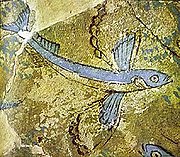constellation in the southern celestial hemisphere From Wikipedia, the free encyclopedia
The constellation Volans is a group of stars in the southern sky. It is in the shape of a flying fish. The name Volans is a shortened from of its original, Piscis Volans. Volans was one of twelve constellations created by Petrus Plancius. He made these constellations from observations by Pieter Dirkszoon Keyser and Frederick de Houtman. Volans first appeared on a 35-cm diameter celestial globe published in 1597 (or 1598) in Amsterdam by Plancius with Jodocus Hondius. The first image of this constellation in a celestial atlas was in Johann Bayer's Uranometria of 1603.
| Constellation | |
 List of stars in Volans | |
| Abbreviation | Vol |
|---|---|
| Genitive | Volantis |
| Pronunciation | /ˈvoʊlænz/, genitive /vɒˈlæntɨs/ |
| Symbolism | the Flying Fish |
| Right ascension | 8 |
| Declination | −70 |
| Quadrant | SQ2 |
| Area | 141 sq. deg. (76th) |
| Main stars | 6 |
| Bayer/Flamsteed stars | 12 |
| Stars with planets | 1 |
| Stars brighter than 3.00m | 0 |
| Stars within 10.00 pc (32.62 ly) | 1 |
| Brightest star | β Vol (3.77m) |
| Messier objects | 0 |
| Meteor showers | 0 |
| Bordering constellations | Carina Pictor Dorado Mensa Chamaeleon |
| Visible at latitudes between +15° and −90°. Best visible at 21:00 (9 p.m.) during the month of March. | |


There are two double stars in the constellation which can be observed using a small telescope, Gamma Volantis and Epsilon Volantis. There are also two galaxies that may be more difficult to see clearly, NGC 2442 and NGC 2434. The magnitudes of the Gamma Volantis stars are fourth and sixth, and of Epsilon Volantis fourth and eighth.[1][2]
Seamless Wikipedia browsing. On steroids.
Every time you click a link to Wikipedia, Wiktionary or Wikiquote in your browser's search results, it will show the modern Wikiwand interface.
Wikiwand extension is a five stars, simple, with minimum permission required to keep your browsing private, safe and transparent.